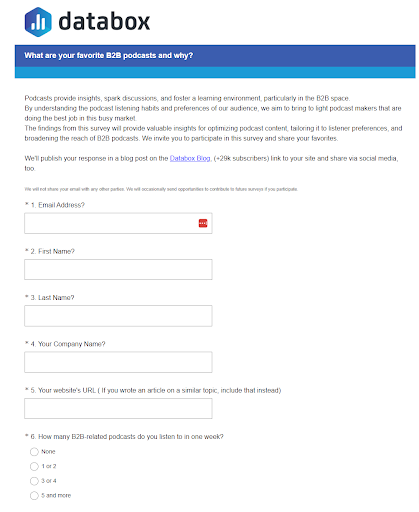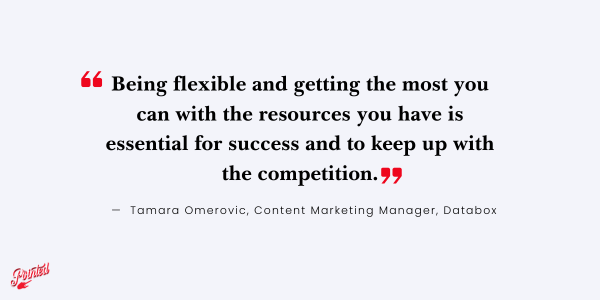Tamara Omerovic runs a small team with a BIG job.
As Content Marketing Manager at Databox, she’s in charge of all things content, from generating new ideas to overseeing the creation of the team’s well-known data reports.
With four awesome marketers on board, plus a separate product marketing team dedicated to middle- and bottom-of-funnel content, Tamara has been known to ship up to 10 data reports per month.
“We even have a Marketing Research Analyst in the team who designs our surveys and makes sure we ask the right questions. It’s a very research driven team. And that is something that really sets us apart,” explains Tamara.
She’s not kidding. Databox is known for their dedication to quality metrics and Tamara and her team are definitely walking the walk. We caught up with the content ace to find out how Databox utilizes their own data for high quality content that attracts over 250K readers per month.
What we’ll cover
- From art history major to content wizard
- How Tamara’s small team shines with quality (over quantity) content
- Align SEO + content KPIs for consistent quality
- How Databox use their own data to reach 250K readers per month
- Impactful content is everything
From art history major to content wizard 🪄
From early in her career, Tamara knew content was her calling.
She was still studying Art History when she started out as a content writer. By the time she’d graduated, she was Head of Content at a Canadian SEO agency.
But it wasn’t long before Databox snapped her up and eighteen months later she was working as Content Marketing Manager under the direction of the brilliant John Bonini.
From maintaining the Databox website and blog, to managing their top of funnel content strategy, Tamara’s scope is huge — and Databox’s unique setup helps her get the most out of her team.
“What’s vastly different at Databox compared to other content marketing roles, is that we’re a research-driven content team and we act as reporters. We run a lot of surveys and do original research reports, while our Marketing Research Analyst creates our surveys and prepares the analysis, the takeaways and the graphics. We also often collaborate with other people to create extensive reports,” she explains.
But maintaining a high level of quality when consistently shipping multiple data reports per month is far from easy. In a landscape where just 1% of B2B marketers rate their content as “excellent”, scaling content without cutting corners remains a challenge for pretty much everyone.

Standing out in a sea of average
When Tamara started on her content journey in 2015, the outlook was much simpler.
“Creating content in the past was just easier. The competition was lower, SEO was much easier to do, social media wasn’t that much on the rise, and content marketers would mostly only focus on one channel. We didn’t have a lot of competitors and content wasn’t as available as it is today,” says Tamara.
But in the seven years Tamara’s been in the game, the content world has become unrecognizable.
“These days we have lots of new tools to help produce content, but most of it’s of average quality. People are experiencing content saturation, not because they’re tired of consuming content, but because they’re consuming too much and too much average, unhelpful content,” she says.
And with 83% of marketers agreeing it’s more effective to create higher quality content less often, Tamara isn’t alone. Still, staying ahead of the curve isn’t always easy.
Here’s how Tamara leads her team to create consistently quality content:
- Involve your audience: “To ensure you can publish multiple pieces a week, even if your budget or teams are small, create content with your audience. Try to run simple surveys, interview experts, and collect some quotes. You can even do it through social media. Just pick five people you admire and ask them to submit a quote for the article you’re writing,” she explains.
- Run historical content optimization: “Updating your existing blog posts is not only important for SEO, but new content pieces emerge every minute and competition is huge — and it’s much easier to optimize your existing piece of content than to start from scratch.”
- Repurpose content on multiple channels: “A good blog topic could also be your podcast topic, LinkedIn post, a good video or even great material for your sales team or your customers. Versatility is key,” says Tamara.
When it comes to creating content worth reading, Tamara believes it truly does take a village. “Including your audience in your content will not only make them feel heard, but you will also build their trust.”
“Producing quality, helpful, unique content is harder than ever before. So when it comes to staying ahead of the game, I believe we should definitely go for quality instead of quantity.” — Tamara Omerovic, Content Marketing Manager, Databox

Databox uses SurveyMonkey forms like this one to collect original data from their audience.
Align SEO + content KPIs for consistent quality
For Tamara, versatility is everything. And from day one it’s been her mission to build a team to reflect that.
“To have a successful content marketing team today, it’s not enough to have a team of great writers or editors. Because content teams typically handle multiple tasks and often have to do them at the same time,” she says. “It’s about having a ‘no excuses’ attitude, and just finding a way to work with what you have available. Being flexible is essential for success and keeping up with competition that grows stronger every day.”
To do that, Tamara believes successful content teams need to align around a common goal. That means the SEO and content team need to work together seamlessly.
“Sometimes it seems like there are basically two sides. Content marketers who are obsessed with SEO, or content marketers who want to completely purge SEO from their content. We shouldn’t do either of those. The SEO obsession even yielded the term ‘SEO content’ and ‘SEO writers’. I believe that doesn’t exist at all. It’s a made-up profession — saying that your content is ‘SEO content’ and that it has to be written a particular way is just an excuse for creating average or mediocre content. And with the second approach, when you’re trying to run away from SEO, you may create great content, but it won’t be found on search,” she says.
The way she sees it, one can’t truly thrive without the other.
“SEO teams and content teams are dependent on each other. Content teams shouldn’t create content without SEO best practices in mind. And SEO can’t be done without good content. Both have the shared goal of enhancing user experience and satisfying user intent. When you use both the right way, you can actually help increase audience engagement and loyalty, and both teams can provide insights to each other,” she explains.
For Tamara, the best way to bring SEO and content teams together is to align them around the same KPIs.
“Data from the SEO team can empower the content team to create pages that not only increase the website visibility but also have the potential to reclaim audience share from the competition,” she explains.
“The most important thing SEO teams can help content teams with is to help them understand user intent because user intent is critical to building a complete marketing funnel. This data ensures content teams don’t miss out on any important opportunity at any stage. When you combine this with good onsite user experience, SEO best practices and a healthy website architecture, this will all bring good results — but it all starts with good content and SEO team alignment,” she says.

How Databox use their own data to reach 250K readers per month
Databox is known for its in-depth analytical reports and focus on audience surveys.
With a strong data-led team on her side, Tamara knows that her best foot-forward is to utilize Databox’s own tools and data to create content that cuts through the noise.
With every project, Tamara focuses on the following key ingredients:
- Pinpoint one goal for each piece of content: “In the past we tried to achieve multiple goals with one piece of content and it was super hard because you need to follow a certain format, a certain structure. Having just a few types of content is much simpler and much stronger. For example, a piece of content that’s great for brand awareness is probably not going to be good for SEO or organic search.”
- Involve the audience: “We don’t create content only for our audience but rather with our audience. Our content strategy revolves around crowdsourcing quotes from experts on different topics relevant to our audience and product.”
- Use existing data to inform content: “Our combination of benchmark data (for, example, how brands are performing) and qualitative survey responses (what brands are doing to influence that performance) is critical data that we think most companies are missing now.”
“It’s okay to have to have a few different goals, but they should all tie to your main business goal.” — Tamara Omerovic, Content Marketing Manager, Databox
Tamara has the luxury of a vast library of data to help fuel her content, but creating in-depth assets at scale — and in a crowded niche — still isn’t easy. Here’s how she approaches it.
“First we create a survey and ask people to share their experiences and opinions. We do a statistical analysis of the sample and feature the best quotes in the final article. Then we email the people featured and promote the post on our social media channels which helps us drive engagement,” she explains.
Let’s break it down:
- First, they start by building a survey with multiple-choice and open-ended questions to help gather data and uncover new insights. This can be a standalone piece of content, or multiple surveys on a specific topic can be used to create an original stats post or report.
- Tamara and her team launch targeted outreach via multiple channels including email, social media and HARO.
- Once they’ve gathered the desired number of responses, they analyze the survey, prepare the data and takeaways, and prepare a brief for the writer — who then summarizes the data and best answers in an article.
- Finally, they publish the report, share it with contributors, and promote it via social media, their newsletter and, when applicable, the Databox Metrics and Chill podcast.
In a super-competitive environment, Tamara knows she needs to focus on up-to-date data — which is why she makes sure to have 5-10 active surveys collecting responses at any one time — while also keeping a hawk-eye on the competition.
“We always look at competitor analysis because when we do blog updates our primary goal is to recover lost traffic and get more signups. I examine the top 10 competitors to check what’s changed. For example, tactics change, data changes, everything changes. So we decide if we need to run a new survey to refresh the data or if we have enough data already from other sources that we can use to update the article,” she explains.
The result? Over the past five years, Databox have had over 13K contributors to the blog, published over 1.3K blog posts and have over 250K monthly readers. 🔥
Impactful content is everything
It’s clear Tamara and her team are slaying the competition — and their success comes down to Databox’s original approach to content.
“The approach we take with original research and sharing data is very important for our content marketing strategy because it helps Databox build a loyal audience that trusts us, position our company as an authority in the industry, and ultimately have people who recommend us to others even if they’ve never been a customer,” she says.
With a strong team and a ton of trusted data on her side, Tamara’s set to continue creating impactful content that makes an unmistakable mark on their audience.
Maddy Bartlett is a freelance B2B copywriter and content specialist. As a former environmental communicator, she believes in working with socially conscious brands to create an impact beyond words. She recently moved to the English outback to focus on what she loves best: growing food, writing and hiking the Dartmoor Way. Find her on LinkedIn.
